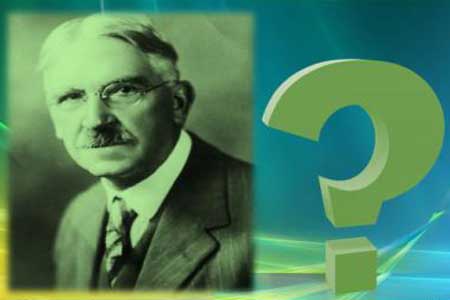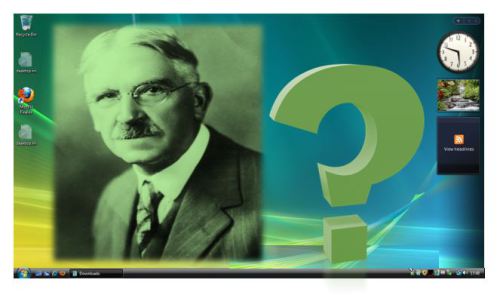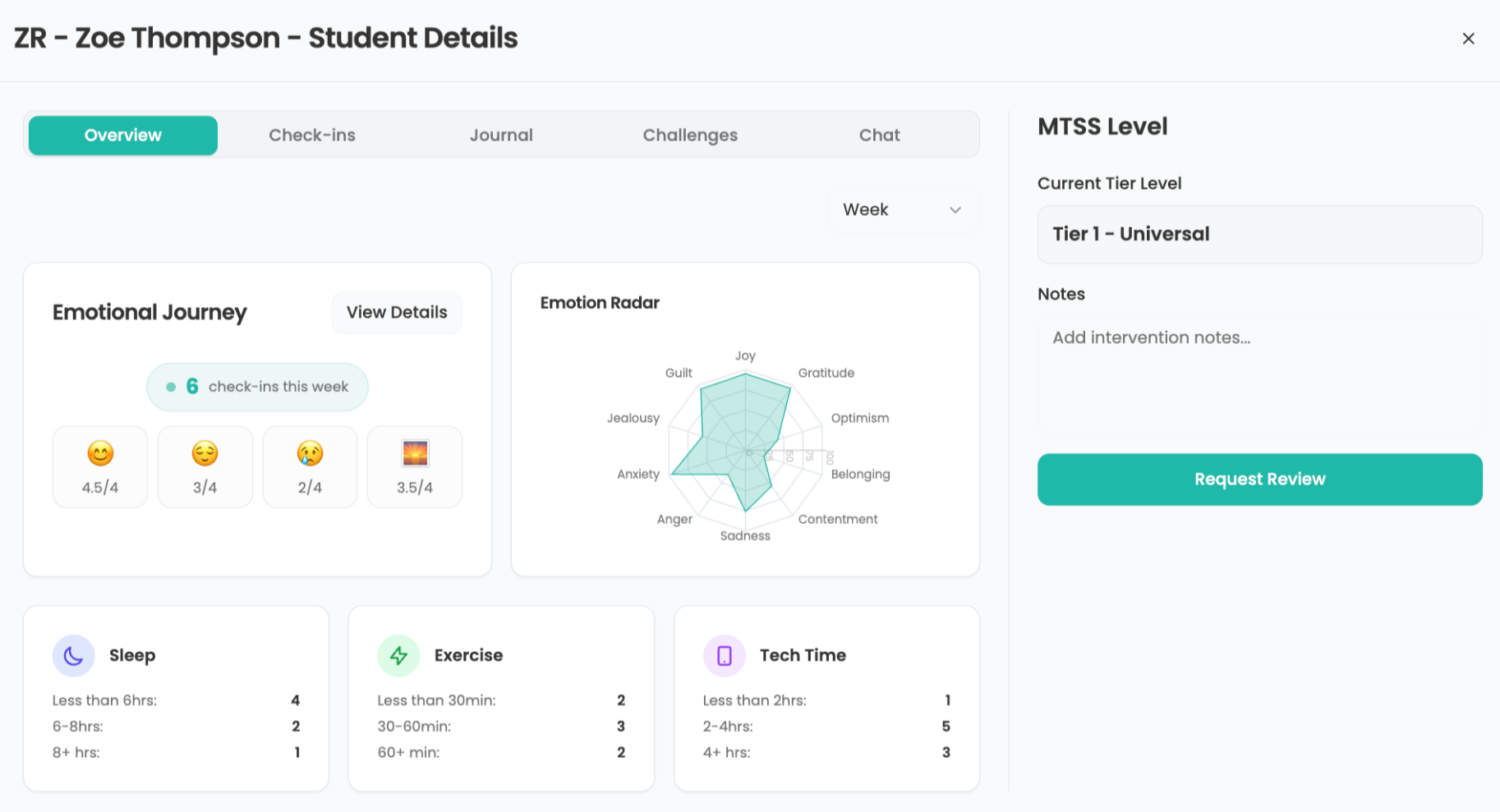What Would Dewey Do? Quotes…Ideas…Resources for Genuine Learning


I have often wondered what John Dewey would do in today’s educational setting with our vast amount of knowledge from research and our rapid growth of technology. I thought I would examine a few Dewey Quotes and see wonderful possibilities for the 21st-century education might surface through reflection. First, please take a moment to subscribe to this blog by RSS or email and join me on twitter at mjgormans . I have some great posts coming your way involving PBL, STEM, tech integration, and a continuing series on Professional Learning Communities! Most of all, thanks for being one of those over 25,000 visitors a month and over 10,000 subscribers. Also, remember that I can come to your conference or school district and provide engaging authentic and purposeful professional development . See booking info and please contact me anytime at (mjgormans@gmail.com). Thanks so much. Michael Gorman (21centuryedtech).
Quick Notes – PBL Opportunities you may want to be aware of:
BLC 16 …. I will once again join Alan November at the BLC conference in Boston in July. I have my own pre-conference master class. It will be an informative and action packed PBL Splash for Teachers and Leaders. Check out both the conference and my pre-conference. This PBL Splash Master Class is almost filled. Sign up soon. I will also be providing some wonderful concurrent sessions to share at the conference.
Making Learning Happen…New York PBL – Join me in Syracuse, New York in August for some exciting PBL workshops. I plan on providing sessions that integrate PBL with STEM, Makers, Differentiated Instruction, Inquiry, Deeper Learning, and Technology Integration. This conference will be filled with amazing speakers and workshops. Hope to see you there!
Using Games, Play + Digital Media To Build Your Own Maker Culture – If you are going to be at ISTE in Denver this summer be sure to stop by this session. Join me, the Institute of Play, and PBS Learning Media. (Wednesday, June 29, 10:15–11:15 am CCC 201)
What Would Dewey Do? Quotes…Ideas… Resources for Genuine Learning
As I prepare for ISTE 2016 I can’t help but think about the amazing thoughts and ideas that John Dewey has brought to education. After all, Dewey emphasized learning by doing and thinking. The world of technology that will be showcased at ISTE would have been an amazing playground of opportunity for John Dewey. As I reflect on this idea I can only wonder, “What Would Dewey Think”? Let’s take a moment and examine a few of Dewey’s quotes and see how these might relate to all the new possibilities that exist today. Please enjoy both the journey, ideas, reflection, metacognition, and resources .
“All genuine learning comes through experience.” – John Dewey
As you might know, I am a big believer in PBL (Project Based Learning. My work at the BUCK Institute (BIE) has affirmed my belief. This quote emphasizes that learning is based on experience. Also, note the concept of “genuine learning”. In this day of standardized testing, I feel that possibly our students are actually memorizing, and not learning. As educators, many of us reluctantly have become standards pushers with our students at the receiving end. Actually, standards are a good thing as long as they are the foundation for genuine learning. This type of learning demands that we give our students experiences that provide a base for understanding the standards. It is also important to understand our students past experiences so that we can build on that. Remember that we acquire and create new knowledge and understanding as we assimilate past experiences into new experiences. You may wish to examine these links that lead to resources on PBL possibilities!
Tools and ideas to transform education. Sign up below.
BIE Tools – PBL Project Search – Here you will find a collection of 450 proven lesson plans to set any PBL desire into action. Look at the database found on the right-hand side of the page.
West Virginia PBL Project Data Base – This is a wonderful site where teachers can search through the subjects of reading, language arts, math, science, social studies, dance, visual arts, theater, and music. You can select from grade two all the way through grade twelve. These are PBL projects made by teachers for teachers!
Learning Reviews – This website claims to connect kids to learning on the web. It really connects kids to awesome, engaging, rigorous, and relevant projects. It points to numerous websites on the internet that house some great PBL possibilities. To see project-based learning lessons sorted by subject go to:
- PBL Language Arts Projects by grade level
- PBL Science Lesson Ideas by topic
- PBL Math Project Ideas by topic
- PBL Social Studies Project Ideas by grade level
Edutopia – This amazing education resource center provides research, ideas and reflection while pointing to other wonderful resources on the web. Please note that the provided link will lead you to the PBL area of Edutopia.
“Method means that arrangement of subject matter which makes it most effective in use. Never is method something outside of the material.” – John Dewey
Wow, take a moment to reread this a few times! Every time I read this I wonder if our traditional education institutions honor this idea. How do we arrange our subject matter and how often are related content areas taught in isolation? I do believe that STEM education provides some answers, but in many STEM schools the content may be embraced but the arrangement of subject matter has not changed. I also believe that Dewey may be suggesting that method and material must work together in order to provide real learning. Sometimes we even get caught up with multiple and unaligned teaching pedagogy and methods. Consider the initiative overload teachers are experiencing! Of course. we have all of the BL’s which include; PBL, PrBL, DBL, CBL, GBL, IBL, SBL, and ABL. Let’s not forget STEM education, unless if your school has initiated STEAM, STREAM, or even STEAMIE! Of course, there is still Flipped Learning, 1 to 1 Programs, Blended Learning, Maker Movements, Genious Hours, SAMR, Learning Targets, 21st Century Learning, the 4C’s, Personalised Learning, Digital Textbooks, and OER! I believe all of these can work together by looking at all of them from Dewey’s thought in this quote. Take a moment to read about my A-G Learning Blocks that I am currently working on that connects with this Dewey quote.
A-G Learning Building Blocks …. Connecting the Initiatives – This is a concept that I have been putting together and you will see future posts dedicated to this idea in this blog. In the space below you will find an outline of these blocks. I believe that if teachers vet their learning experiences with these A- G Blocks they will provide their students learning experiences that facilitate many learning initiatives. Each block has four indicators which I will be relating as I publish future articles. The A-G Blocks include the following:
- Block A – Authentic Learning
- Block B – Blended in Technology
- Block C – Centered on Students
- Block D – Developmental and Formative
- Block E – Endless Inquiry
- Block F – Focused on Connections
- Block G – Grounded in Standards
This quote is really worth taking a moment to reflect on. While as educators we believe this, are we always putting “thinking” to practice in this standards overloaded culture we work in? Once again, standards are important but only if they engage thinking. Remember that first quote and the idea of “genuine learning”. Once again we need to define our concept of learning. As I reflect on this quote I am reminded that we must examine the standards and look for not just the facts, but also the thinking. Many times this thinking involves “doing” as related in my favorite Dewey quote that comes up next. This is what moves students up Bloom’s Taxonomy while landing them in Webb’s Depth of Knowledge. Please take a look at the process of examining the standards I provide below to ensure that facilitating the standards include both thinking and doing.
Five Tasks (steps)… Finding the Thinking and Doing in the Standards
- Identify the standard (It is sometimes referred to as a Power Standard which would be broken down to specific grade level)
- Reflect on the standard… if possible collaborate with others (What does the standard mean, why are we teaching this, what should students know, what should students be able to do, how does it apply to students at my grade level, where might it stand on a Depth of Knowledge Chart or Bloom’s Taxonomy)
- Determine the content (facts) by reviewing the standard and circling the appropriate nouns.(This will help you determine content and allow you to determine what is appropriate for your level of students.
- Investigate the skills (thinking and doing) by reviewing the standard and circling the appropriate verbs. (This will allow you to determine the appropriate skills to be practiced by students. This can be aligned to Depth of Knowledge, Blooms, and/or 21st century 4 C’s.
- Create Learning Targets demonstrating what students will be able to do. (This is done through reflection and listing of verbs and nouns. The nouns allow us to state what students will know, and the verbs allow us to see what students will be able to perform or do.
Let me provide an example below…. note the standards
- Students will be able to research and record key facts involving the planets of the solar system.
- Students will explain orbit, gravity, and gravitational pull.
- Students will be able to collaborate on a presentation that provides what they have learned in their own words
Relevant Nouns (facts) – research, planets, solar system. orbit, gravity, and gravitational pull
Relevant Verbs (thinking and doing) – explain , collaborate , presentation
Learning Targets for students -(putting thinking and doing into action)
- I can research and explain my findings on planets and their relationship to the solar system
- I can collaborate with others to create a presentation
- I can present with others to demonstrate our learning and understanding
Resources for Nouns (facts)
- The Index of Open Educational Resources – Open Educational Resources come in many shapes and sizes. This partial list of sources introduces the scope of OER and the organizations cultivating its increasingly vital role in opening higher education up to the greatest number of people worldwide.
- Open Education Resources – Talk about big, this network brings together 44,129 OER tools for sharing curriculum. It also provides a host of world and news and training on the amazing arena of open education! Great place to investigate whether you have an hour or a month!
Resources for Verbs (thinking and doing)
- Webb’s Depth of Knowledge – Not only take a look at Webb’s Depth of Knowledge but examine how it lines up with Bloom’s.
- Learning Types (look at page 24) = While page 24 presents doing and thinking from a learner’s perspective, the entire document is filled with a lot of doing and thinking.
- SAMR Padagogy Wheel – Take doing and thinking to the digital level. Examine multiple processes including SAMR, Blooms, and Digital Apps. While it was written with the iPad in mind, most of the apps cross over to the Windows and Chrome world.
- Blooms Digital Taxonomy = Take a look at Blooms in a whole new way. A wonderful resource allowing you to examine the different levels of Blooms in an interactive way.
Resources for Learning Targets (taking action)
- Graphite Lesson Flow– Formerly known as App Flow, Graphite’s lesson Flow from Common Sense media allows teachers to incorporate the very best in digital tools, while highlighting their pedagogical insight. Watch their video in order to learn more about Lesson Flows or make your own and share it by clicking “Create your own lesson flow” when you visit the site.
- Gooru– Browse thousands of K-12 collections made by teachers, or search over 16M resources. Best of all, contribute your own while you share and learn from others. Explore Gooru’s ability to provide lessons with formative assessment and feedback.
- Learn Zillion – This site has some wonderful vetted lessons. First, you must become a member… which is free. Then visit the resource area and do a search. You will note some lessons are free and some may have a small cost.
- PBS Learning Media– While best know for some amazing videos, PBS Learning Media also has some wonderful lesson plan resources and interactive. You will also be amazed at the engaging teacher tools for the 21st-century classroom.
- Lesson Plan Data Base – This is a very simple search engine database that I built and house at my site. You will find that it links up to lesson plans in all subject areas. It uses many of the same strong educational sites that Thinkfinity (which is no longer available as a search engine) once used. Be sure to use the search area under the words “Lesson Search”. Make sure you check it out.
Welcome to my very favorite John Dewey quote. You have to read this one a few times and then read reach line between the commas. It really explains what “genuine learning” is all about. Think of it in these three steps:
- Step 1: Give the pupils something to do, not something to learn (This reminds us that we must go beyond facts, provide the proper method, provide new experiences that build on past experiences, and let our students do and think!)
- Step 2: and the doing is of such a nature as to demand thinking (At this point it can be seen that allowing students to do provides that important “thinking time”. It is necessary that teachers provide the time for important student metacognition. It is only when the doing is processed through thought that learning goes beyond the acquisition of mere facts!)
- Step 3: learning naturally results (Once again we must define the definition of learning and go beyond content and fact retention and make sure our students really understand and can connect their learning to new experiences and the real world. It at this point that both educators and students understand the idea of genuine learning!)
This quote brings the total genuine learning experience to a full circle allowing for the doing and the thinking. Please enjoy the links below that will allow you to explore the ideas of metacognition and learning.
- Habits of the Mind Institute – Take a moment to become familiar with these important “Habits of the Mind” that will encourage the important thinking and metacognition to support “genuine learning”.
- BIE 4C’s Rubrics – Are you assessing the 4C;’s and important life skills? Take a look at this portion of BIE’s site to discover some wonderful assessment tools. The BUCK Institute offers an amazing set of rubrics that support assessment for “genuine learning”
- P21 – The Partnership for 21st Century provides a wealth of material and research that will provide ideas and possibilities that emphasize “genuine learning”.
- The Right Question Institute – Inquiry is the foundation for great thinking and metacognition. Here you will learn to not just answers, but also how to construct great questions which will lead your students to “genuine learning”
cross-posted at 21centuryedtech.wordpress.com
Michael Gorman oversees one-to-one laptop programs and digital professional development for Southwest Allen County Schools near Fort Wayne, Indiana. He is a consultant for Discovery Education, ISTE, My Big Campus, and November Learning and is on the National Faculty for The Buck Institute for Education. His awards include district Teacher of the Year, Indiana STEM Educator of the Year and Microsoft’s 365 Global Education Hero. Read more at 21centuryedtech.wordpress.com.
